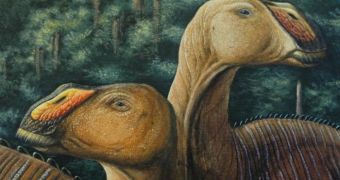This was a giant in the world of the duck-billed dinosaurs. It lived in what is now southern Utah, some 75 million years ago. The well-preserved skull reveals a muscular vegetarian, with hundreds of teeth and huge jaws. "It could have eaten whatever [vegetation] was in its way," said lead researcher Terry Gates, a paleontologist at the University of Utah in Salt Lake City.
The skull comes from Late Cretaceous period, and is now preserved at the Utah Grand Staircase-Escalante National Monument. A team of high school students and volunteers first encountered the fossil in remote sandstone badlands in 2002. The new species, named Gryposaurus monumentensis in honor of the national monument where it was discovered, was among the most abundant herbivorous of the Cretaceous. "In North America, duck-billed dinosaurs were like the antelope of the African veldt-common overall, but highly variable and fantastic in appearance," said Philip Currie, a paleontologist at the University of Alberta in Edmonton, not involved in the research.
Other species of Gryposaurus had previously been unearthed in Montana and Alberta (Canada), but none knew if they lived further south. "The identification of the new specimen from Utah has ended this debate. It is exquisitely preserved. The new study clearly shows that this dinosaur had diversified into multiple species over a huge geographic area.", said Currie. "Differences between species of Grypsaurus suggest that some sort of unknown barrier may have prevented populations from mixing", said Gates.
But the Utah species was huge compared to its northern relatives: up to 30 ft (9 m) long and 10 ft (3 m) tall. "The bones were larger, and the lower jaw was much stronger than [in] other species," Gates said.
The beak, too, was much larger. Probably, this dinosaur fed on tough, woody plants, using its powerful jaws, in a wet floodplain. "There was no grass but probably lots of conifer trees and flowering plants. It would have been lush. With its robust jaws, no plant stood a chance against G. monumentensis", Gates said.

 14 DAY TRIAL //
14 DAY TRIAL //